While helping with the fall 2013 Habitat Stewards class today at Hornsby Bend, I stopped to admire the construction and predatory skills of a few beautiful spiders who had picked prime flying-insect-rich real estate in which to build their giant webs.
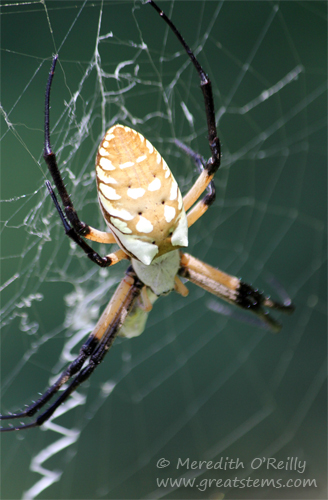
Argiope aurantia, known as the common garden spider, is generally a large yellow and black spider, though of course it can have color variations as you see above. Its big web can easily be two feet across, not including the framework. While Argiopes are generally considered solitary spiders, the insect activity in the area was enough to keep several of the spiders in close proximity. Danger, insects, danger!
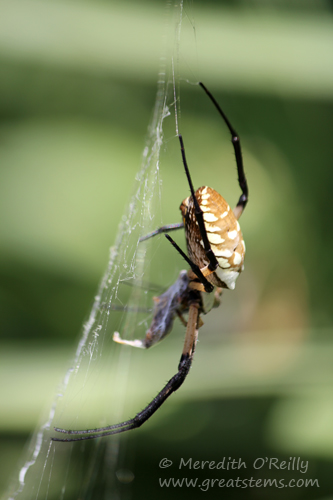
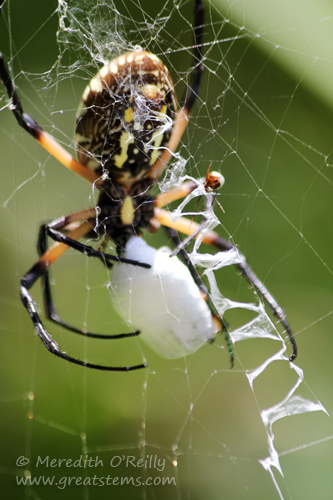 The garden spiders are sometimes called Writing Spiders because of the zig-zagged stabilimenta they create in the center of their webs.
The garden spiders are sometimes called Writing Spiders because of the zig-zagged stabilimenta they create in the center of their webs.
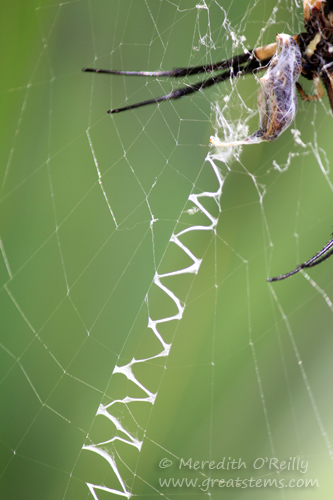 Here’s a better view of the stabilimentum of one of the Argiope aurantia. There are many theories about why some diurnal orbweaver spiders create such features in their webs, but it would seem that the stability theory for which the stabilimentum got its name has been disputed. It’s possible, though, that it has something to do with visibility, mating, predator avoidance, or attracting prey.
Here’s a better view of the stabilimentum of one of the Argiope aurantia. There are many theories about why some diurnal orbweaver spiders create such features in their webs, but it would seem that the stability theory for which the stabilimentum got its name has been disputed. It’s possible, though, that it has something to do with visibility, mating, predator avoidance, or attracting prey. 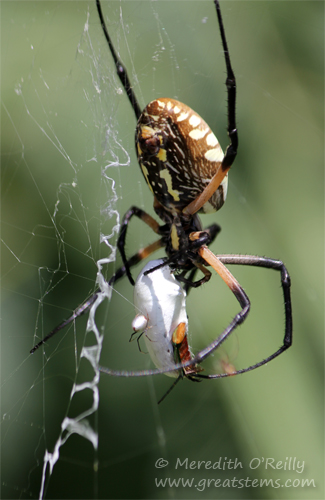
But the real story today isn’t about the gorgeous garden spiders, which normally would have me oohing and aahing. Okay, I’m still oohing and aahing, but what I really mean to talk about is the fact that a big orbweaver such as Argiope aurantia isn’t always the only spider in its web. In the above photo, a tiny dewdrop spider (Argyrodes elevatus) is sharing the meal of the larger spider.
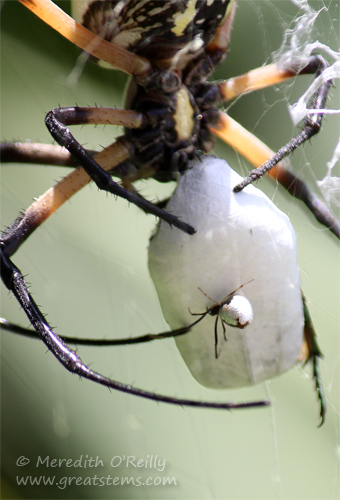
If you know how big garden spiders can get, then you should have an idea about just how much smaller the little dewdrop spider is. Yet there it is, bravely coming in to get some of food caught by the bigger spider. Dewdrop spiders, by the way, are members of the cobweb-weaver family. Presumably they are capable of building their own web, but why bother if they can steal from another predator instead? Clever little spiderses.
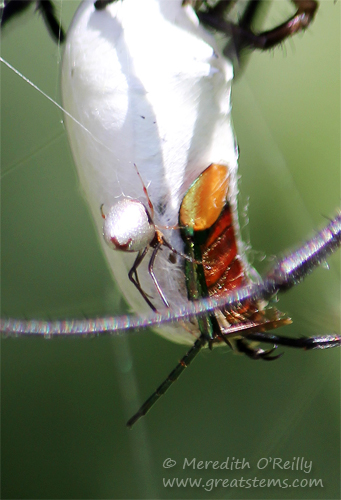
This behavior of stealing food is called kleptoparasitism. Cuckoo bees, seagulls, hyenas, and vultures — and our dogs — are some of the other animal species known to be kleptoparasitic, at least occasionally. In the case of our arachnid friends, sometimes a thieving spider will make a meal of tiny insects that get caught in the big web, and in doing so it helps keep the web clear without really affecting the Argiope spider. But when a nice big juicy bug gets caught and subsequently nabbed by the large garden spider, the little dewdrop spider will carefully approach the wrapped and pre-digested larger prey and secretly consume some of it, while making sure to avoid the attention of the big predator close by, lest it become a meal itself. Actually, some kleptoparasitic spiders have also been known to eat the host spider, but presumably the big spider has to die first.
Speaking of which, I watched a huge metallic beetle fly into another big web and got ready to take pictures of the sudden ambush from the orbweaver. But the orbweaver didn’t move, despite violent and desperate attempts of the beetle to escape the sticky web. I took a small twig and gently nudged the spider, and it didn’t move. I wonder why it died in the center of its web — very odd. No klepto spiders were eating it yet; perhaps they will, though, or maybe a bird will swoop it up if it can do so safely. Meanwhile, I used the twig to release the beetle, and it flew away to live another day… or at least a few more minutes until it zips into another silky deathtrap.
Claude at Prickly Plants and Garden Rants just posted about a Yellow argiope spider… Very cool, all of them, really.